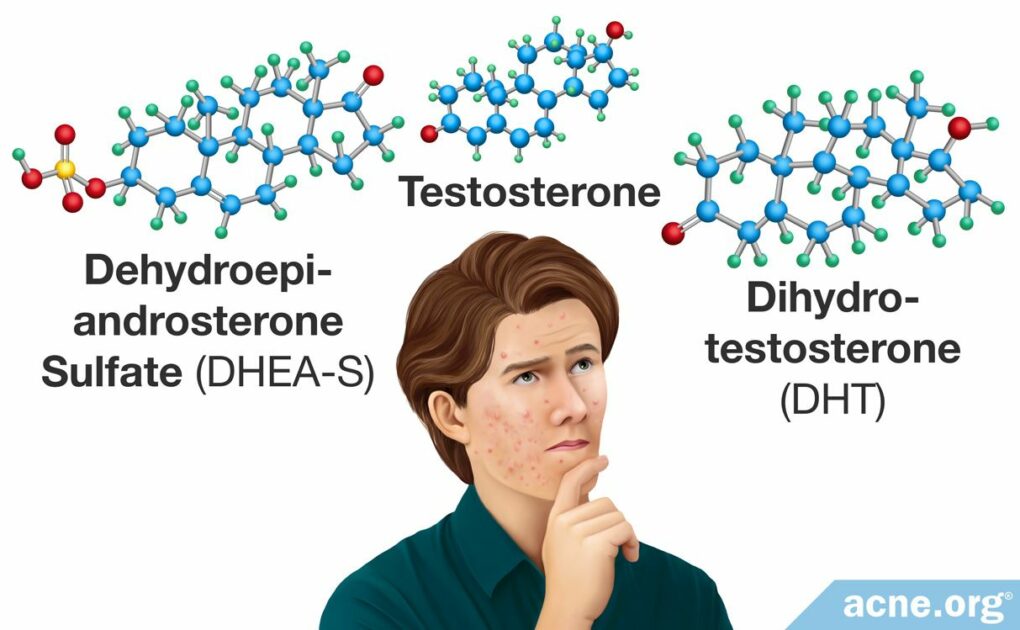When It Comes to Acne, Androgens – which Are Male Hormones Present in Both Males and Females – Are at Fault

The Essential Info
You may have heard of the term “hormonal acne” before, but the term “hormonal acne” is something of a misnomer. In fact, all acne is hormonal. Hormones are necessary for acne to start, which is why we see acne afflicting young people as they hit puberty and the body starts to produce hormones.
Specifically, it is androgens, which are male hormones found in both males and females, that are crucial to the development of acne. Androgens increase the amount of skin oil, called sebum, that the body produces. Here’s how hormones lead to acne, generally speaking:
- The more androgens the body produces, the more sebum that is produced
- The more sebum that is produced, the more acne asserts itself
There are three main types of androgens involved in acne:
- DHT
- Testosterone
- DHEA-S
All three stimulate the production of sebum.
Many factors can result in increased androgen levels, but puberty is the universal culprit in most cases.

The Science
Androgens are male hormones found in both males and females, although they exist in a smaller amount in females.1 In acne, androgens are responsible for stimulating the production of skin oil (sebum) as well as thickening the skin, which can lead clogged pores and breakouts.2 Acne first develops during puberty because puberty is the stage at which the body begins synthesizing androgens.
However, the relationship between androgens and acne is not entirely clear-cut for the following two reasons:
- In some acne patients, normal levels of androgens can still bring about increased sebum production. In this case, it may be that sebum-producing cells (sebocytes) in some acne patients are more sensitive to androgens than others. In other words, the same amount of androgens can cause sebum-producing cells of some people to produce more sebum than other people.
- People with the highest androgen levels do not necessarily have the most severe acne. Therefore, as a whole, scientists believe that it’s not just how much androgen levels are raised above normal, but rather how a person’s body reacts to these elevated levels, that may determine acne severity.3-5
Sometimes androgen levels and the body’s sensitivity to them may not tell the whole story. For example, when it comes to sebum, androgen levels are not the only thing that determines how much sebum a person’s skin produces. Sebum production can also be regulated by the size of skin-oil producing glands in the skin: the larger the glands, the more sebum is produced. The largest skin oil glands are found on the back, neck, chest, and face, which explains why acne develops more often in these areas of the body.1,2,6
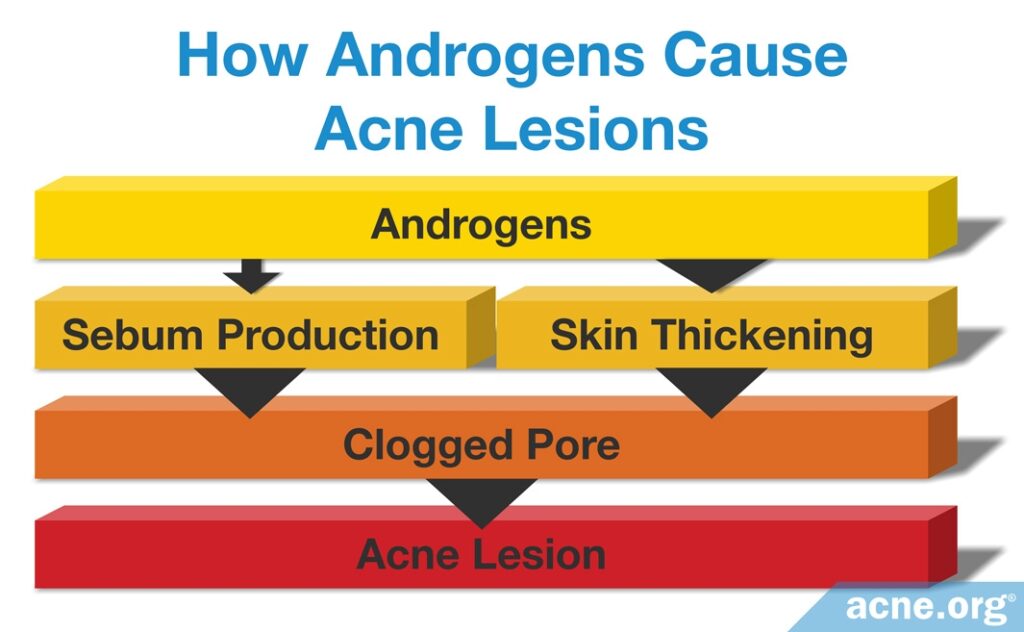
Types of Androgens

There are many types of androgens, but only three relate to acne.
- Dihydrotestosterone (DHT)
- Testosterone
- Dehydroepiandrosterone sulfate (DHEA-S)
Expand to read more about these three androgens
- Dihydrotestosterone (DHT) is the most powerful androgen, and it can cause an increase in sebum production.
- Testosterone is another powerful androgen that can cause an increase in sebum production. Sometimes, if the body needs more DHT, it can convert testosterone into DHT through a special protein called 5α-reductase (5-alpha reductase). This increased production of DHT will also lead to more sebum production. In the past, scientists believed that testosterone only increased sebum production after the body converted it into DHT. Following that idea, they used drugs that prevented the 5α-reductase conversion of testosterone into DHT to prevent sebum production and treat acne with some success. However, some research has shown that testosterone can increase sebum production by itself, so drugs that only inhibit the conversion of testosterone into DHT may not always be effective in this regard to treat acne.6,7
- Dehydroepiandrosterone sulfate (DHEA-S) is a weak androgen that the body can convert into DHT or testosterone if it is in need of a more powerful androgen. Researchers have found that although weaker than either hormone, DHEA-S is more abundant in sebum-producing cells than DHT or testosterone. This suggests that controlling it may be just as important as controlling other androgens that regulate sebum production. In fact, researchers have found that in acne patients, higher DHEA-S levels are most strongly associated with higher sebum output.2
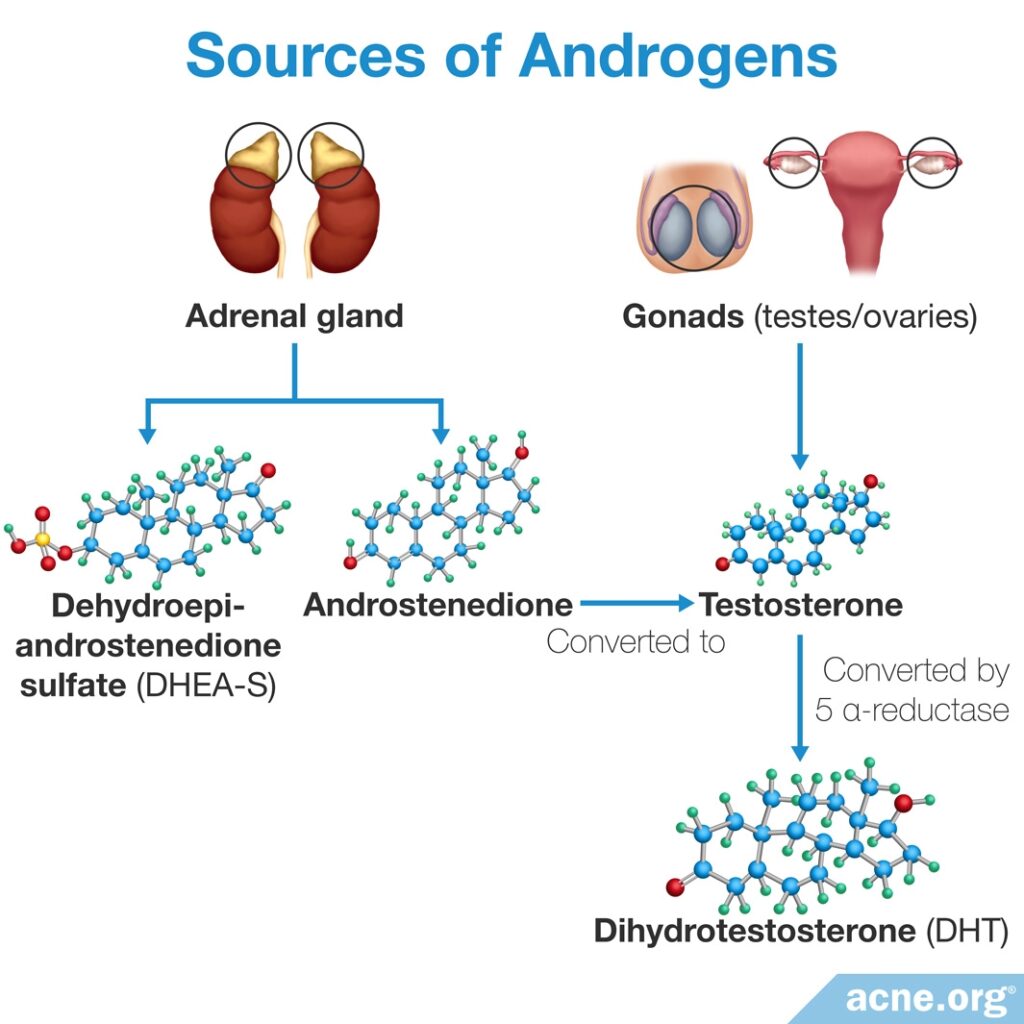
What Causes an Increase in Androgens?
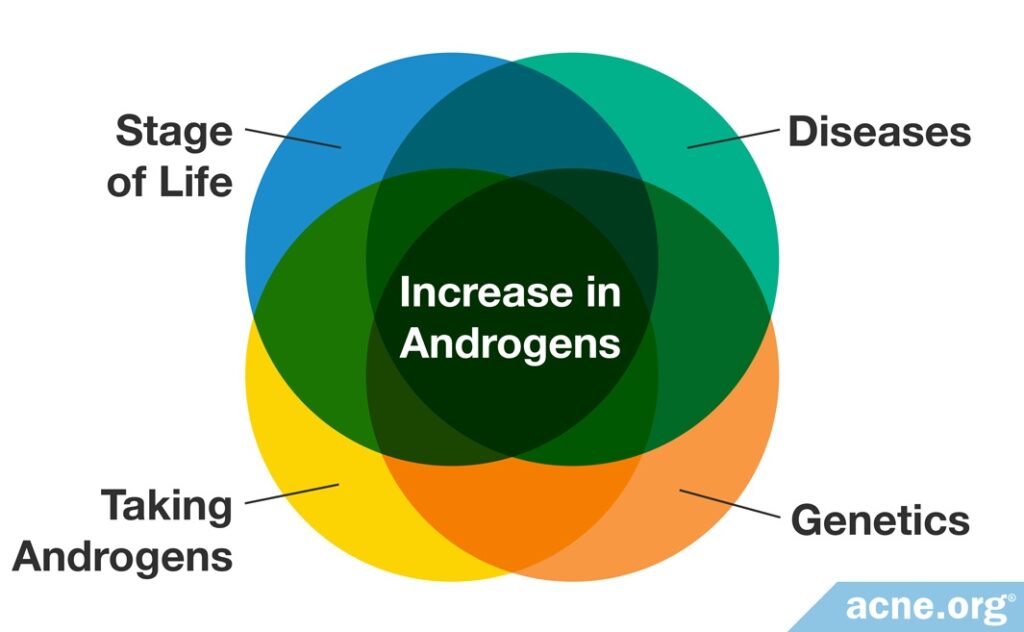
There are four main factors in the case of increased androgen levels.
- Age: The age of a person drastically affects their hormone levels. When we are born, there is a small surge of androgens, which sometimes results in the development of baby acne, called acne neonatorum. During childhood, the production of androgens decreases, which explains why children almost never develop acne. During puberty, however, the production of androgens peaks, which results in the emergence of acne during the teenage years. If a person does not go through puberty, as in the case of castrated men, then they will not develop acne because they lack androgens.6-8
- Diseases: Certain diseases can cause an increase in androgens. These diseases often affect the glands and organs responsible for producing them, such as the adrenal glands (glands above the kidneys), ovaries (female reproductive organs), and the pituitary gland (gland at the bottom of the brain). Examples of such diseases include adrenal gland tumors, adrenal hyperplasia (increased adrenal tissue), ovarian tumors, and polycystic ovaries, among others.6
- Genetics: A person with an extra Y chromosome will produce more androgens. A normal male possesses two sex chromosomes: an X and a Y (XY). If a male has an X and two Ys (XYY), then he will produce more androgens.
- Taking androgens: Using anabolic steroids for muscle growth can lead to huge increases in androgens and severe acne. However, testosterone is sometimes prescribed purely for medical purposes and this can also cause an increase in androgens.6
References
- Androgen, Wikipedia. https://en.wikipedia.org/wiki/Androgen
- Toyoda, M. & Morohashi, M. Pathogenesis of acne. Med Electron Microsc 34, 29 – 40 (2001). https://www.ncbi.nlm.nih.gov/pubmed/11479771
- Iftikhar, U. & Choudhry, N. Serum levels of androgens in acne & their role in acne severity. Pak J Med Sci 35, 146 – 150 (2019). https://www.ncbi.nlm.nih.gov/pmc/articles/PMC6408631/
- Kiayani, A. J. & Rehman, F. U. Association of serum testosterone and sex hormone binding globulin levels in females with acne based on its severity. J Ayub Med Coll Abbottabad 28, 357 – 359 (2016). https://www.ncbi.nlm.nih.gov/pubmed/28718568/
- Uysal, G., Sahin, Y., Unluhizarci, K. et al. Is acne a sign of androgen excess disorder or not? Eur J Obstet Gynecol Reprod Biol 211, 21 – 25 (2017). https://www.ncbi.nlm.nih.gov/pubmed/28178574
- Degitz, K., Placzek, M., Borelli, C. & Plewig, G. Pathophysiology of acne. JDDG 5, 316 – 323 (2007). https://www.ncbi.nlm.nih.gov/pubmed/17376098
- Leyden, J. et al. A systemic type i 5 α-reductase inhibitor is ineffective in the treatment of acne vulgaris. J Am Acad Dermatol 50, 443 – 447 (2004). https://www.ncbi.nlm.nih.gov/pubmed/14988688
- Cunliffe, W. et al. Comedone formation: Etiology, clinical presentation, and treatment. Clin Dermatol 22, 367 – 374 (2004). https://www.ncbi.nlm.nih.gov/pubmed/15556720
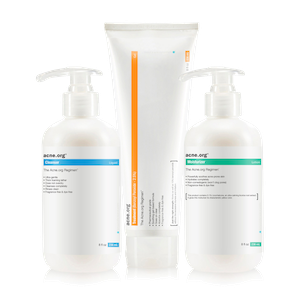 Acne.org Products
Acne.org Products